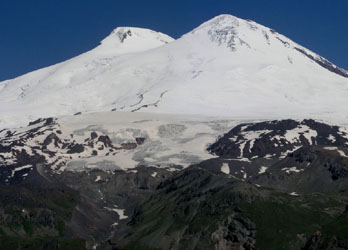Elbrus
- Elbrus
- 5642 m
- Primary factor 4741 m
- Location: North 43:21.152, East 42:26.270 (GPS on the summit)
- Location: At the end of the Baksan Valley, near the village of Terskol.
- Highest in the Caucasus
- Saddle: 901 meter, just across the border west in Pakistan
- Saddle location: N26:33:39, E063:39:17
- Difficulty: Grade F+, YDS class 2+, snow/ice climb.
- Climbed August 5 and again on August 8, 2004.
